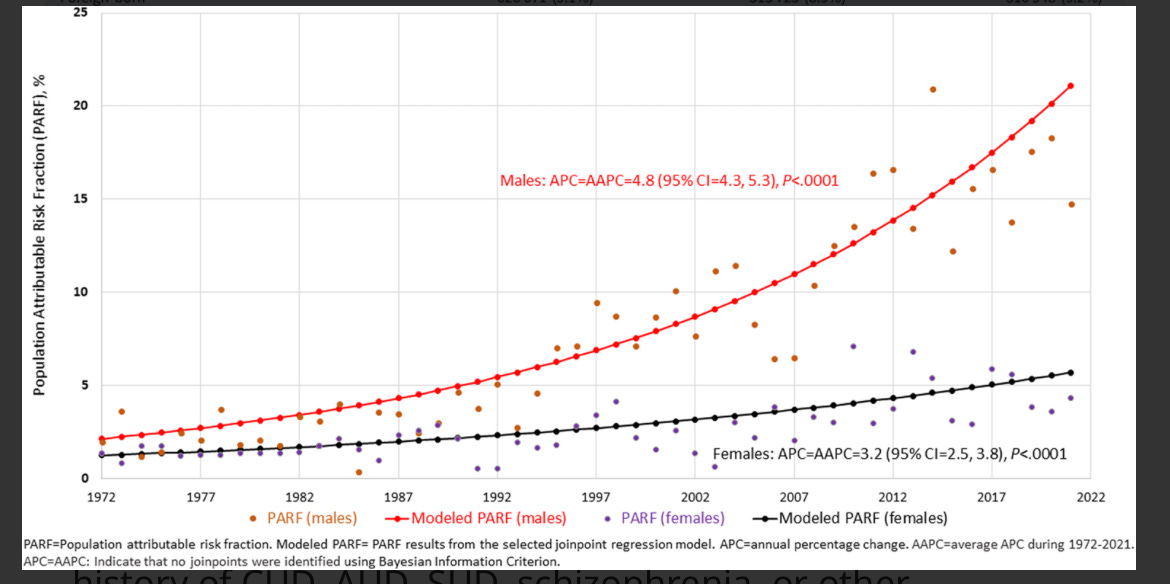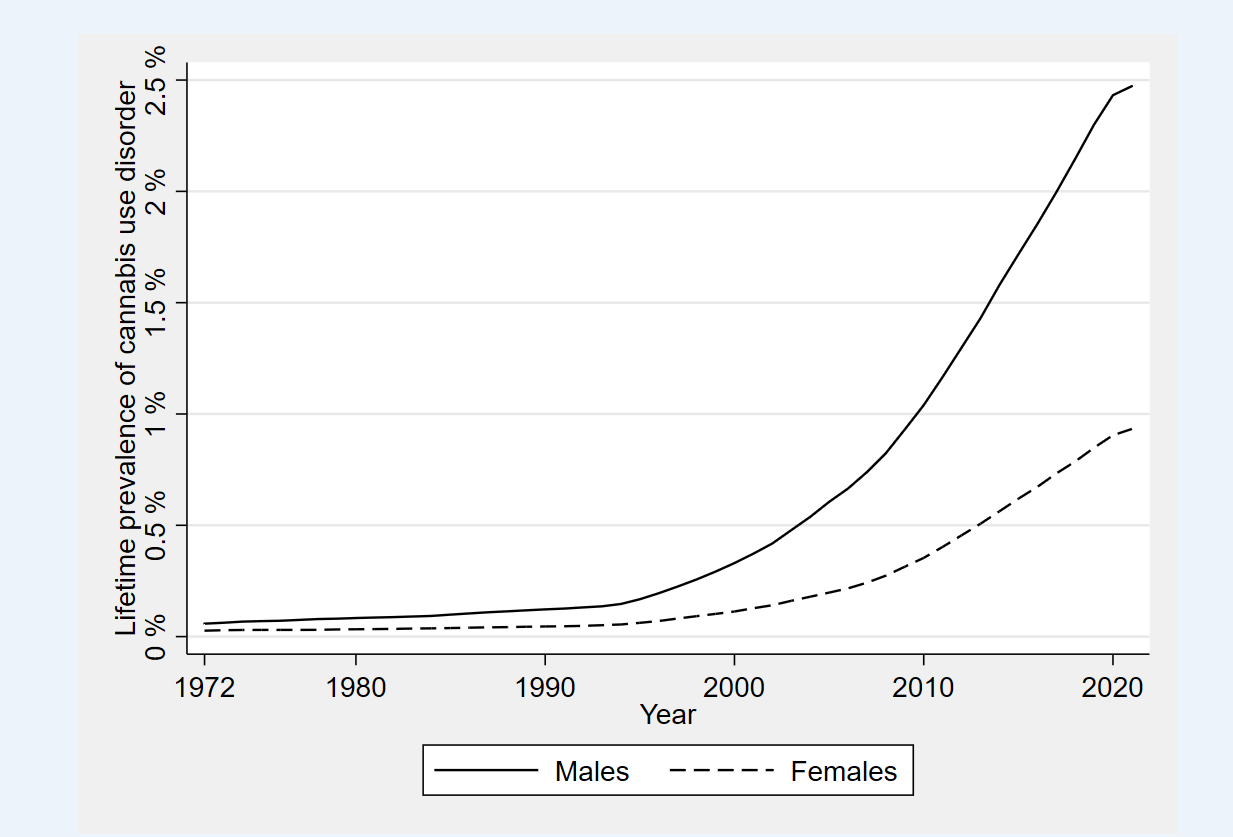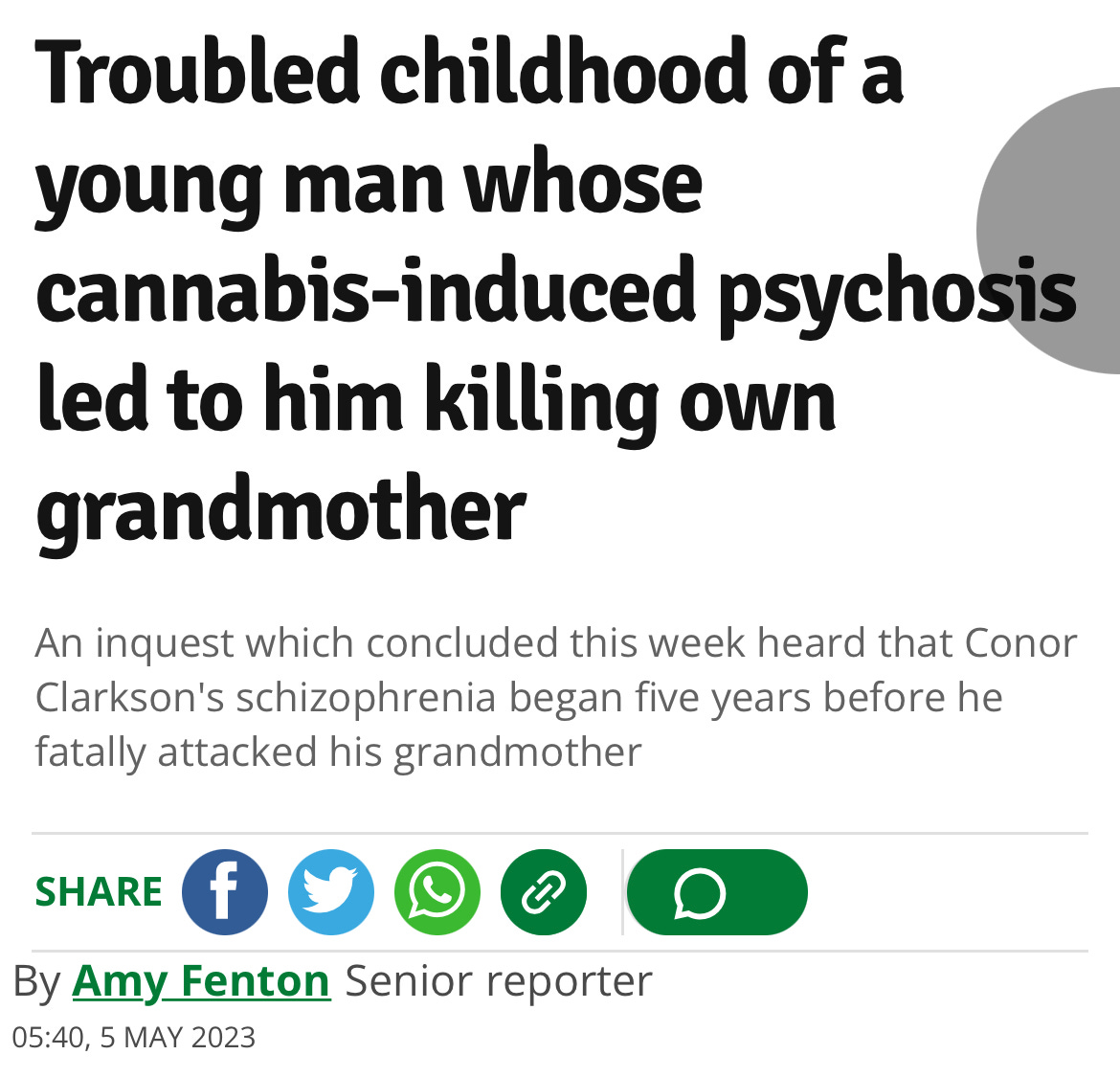Tell Your Children
A new study out of Denmark has the most disturbing findings yet about the link between cannabis and schizophrenia
Cannabis now causes up to 1 in 4 cases of newly diagnosed schizophrenia in young men, Danish researchers have found.
Based on their analysis, cannabis is now by far the highest non-genetic risk factor for schizophrenia, a devastating mental illness.
Schizophrenia’s best-known symptoms are paranoia and hallucinations, but the illness also damages motivation and even reduces overall intelligence. And people with schizophrenia are at high risk of committing violence.
The study new suggests the United States, which has much higher cannabis use than Denmark, could already be seeing a rise in schizophrenia cases. But since the United States does not even try to count new schizophrenia diagnoses, knowing for certain is nearly impossible.
—
(TELL YOUR CHILDREN, MY BOOK ON CANNABIS, PSYCHOSIS, AND VIOLENCE, CAME OUT IN 2019. SUBSCRIBE NOW - FOR NEWS THE REST OF THE MEDIA WILL REPORT YEARS LATER:)
—
—
The link between problematic cannabis use and the illness has risen dramatically in the last 50 years, the researchers found. Over the same period, cannabis has become far more powerful, with much higher levels of THC - the chemical responsible for its psychoactive effects.
The researchers could track the changes because Denmark’s national health care system that let them see all new diagnoses of both schizophrenia and cannabis use disorder - or marijuana addiction. They examined how many people with the disorder were later diagnosed with schizophrenia. Then they adjusted for other factors known to cause schizophrenia, such as a family history of mental illness.
The study was massive, covering the health records of almost 7 million people, Denmark’s entire population from 16-49 from 2012.
(When you see that red line, think ruined lives. In 1972, barely 2 percent of new schizophrenia cases in men were attributable to heavy cannabis use. In 2022, about 20 percent were.)
They found that cannabis use disorder was a stunningly powerful signal for a coming schizophrenia diagnosis; someone with the disorder had a 30-fold risk of being later diagnosed with schizophrenia.
Much of that increased risk could be explained by other factors, such as a family history of mental illness, which are also higher in people with cannabis use disorders. But even after they adjusted for all those factors, they found cannabis addiction was associated with a 2.3x risk of developing schizophrenia.
Cannabis addiction was most dangerous for younger men. Men 20 and under had nearly four times the risk of developing schizophrenia if they were heavy users.
Overall, about 15 percent of schizophrenia cases diagnosed in men in 2021 occurred as the result of cannabis addiction, the researchers found. For younger men the percentage was even higher.
Women also had an increased risk for new schizophrenia diagnoses after heavy cannabis use, though it was smaller. The difference may reflect some difference in women’s and men’s brains, or that men use more cannabis than women even within the group of users diagnosed with addiction.
—
Unfortunately, the problem of cannabis-linked mental illness is likely to get worse before it gets better, because more people are using the drug heavily and dangerously.
In the 1970s, standard strains of cannabis usually contained about 2 percent THC. Today, herbal cannabis routinely is 20 percent THC, and near-pure smokable THC extracts called wax or shatter are widely available. THC can also be vaped or ingested in edibles, a method of use that further increases its potency.
As a result, cannabis users routinely consume much more THC now they did a generation ago - leading to more intense and longer-lasting highs and more risk of addiction.
In 1990, only about one out of every 1,000 men in Denmark had ever been diagnosed with cannabis use disorder. Today, the rate is 1 in 40.
(SOURCE)
The trend is similar, but worse, in the United States, where cannabis is now legally available in most states and is widely promoted as medicine.
In a survey in 2021, 11 percent of American young adults reported daily cannabis use, up from 6 percent a decade earlier. (Daily use is not quite synonymous with cannabis use disorder, but it’s not a good sign.)
Of course, the explosion in homelessness, disorder, and violence in American cities - most notable West Coast cities where cannabis use was first legalized - is mere coincidence.
It has absolutely nothing to do with soaring cannabis use and the downstream risk of violence that follows psychosis.
—
Nothing to see here, people. Absolutely nothing.
You’d have to be high to see a pattern.








Thank you for your book and for continuously speaking up about this subject. We lost our daughter, a brilliant young woman, to high potency THC "pens" and the insanity of covid lockdowns. Suicide is a multi-faceted death, but she was an honour roll student, happy, well adjusted and a star athlete before she first tried drugs. All she ever did was "pot" but she developed psychosis within a few months. I speak up for her, and so many other young people we are losing to this insanity that allows profits to trump our children. Again.
I wrote about her story here if any other people are interested in learning how insidious these modern day products are: https://www.slowdownfarmstead.com/p/what-happened-to-our-daughter
Heather Heying, of Dark Horse and Natural Selections fame, also published parts of her story here: https://naturalselections.substack.com/p/milas-story
Thank you for your perseverance and strong spine, Alex. We need more people speaking about this issue with conviction and heart.
It seems that the general population considers marijuana use relatively benign. Younger people in particular seem to regard it as “not a big deal” even if they don’t partake. This is a big problem now leading to being an epidemic.